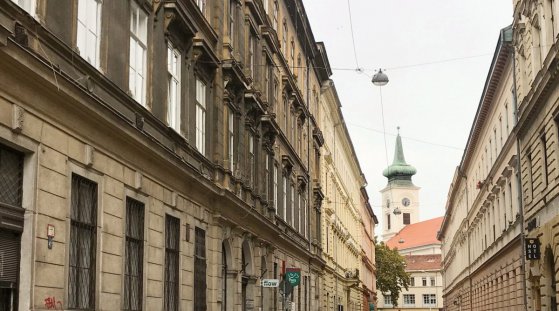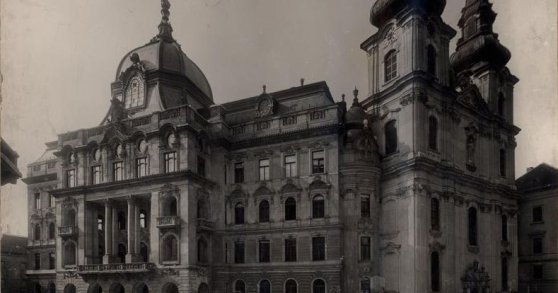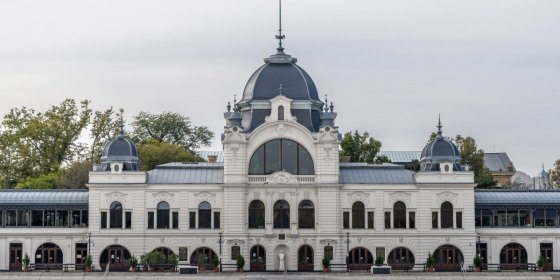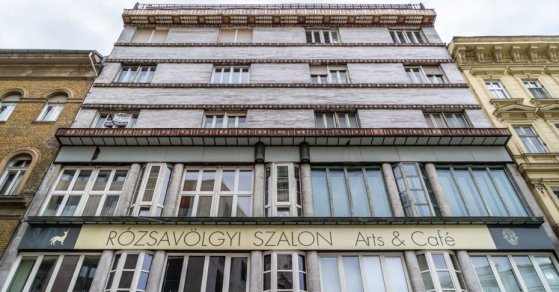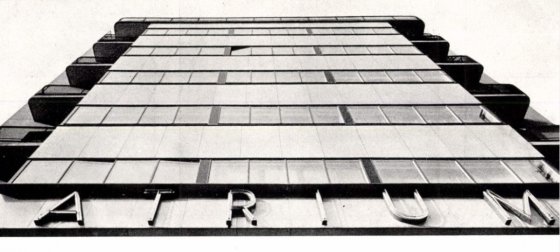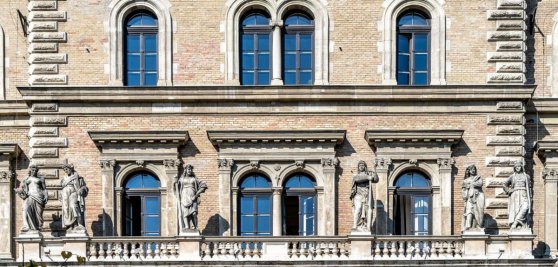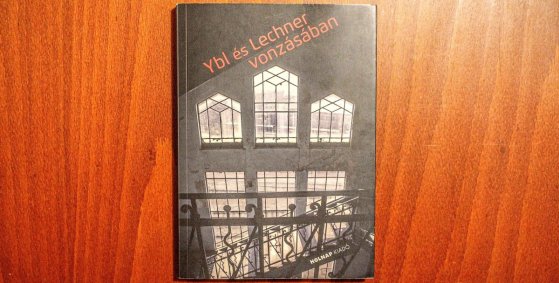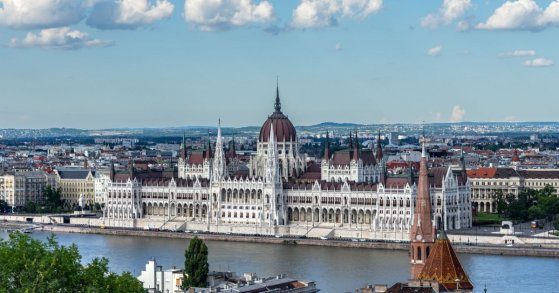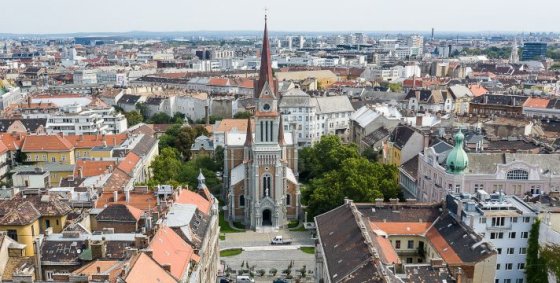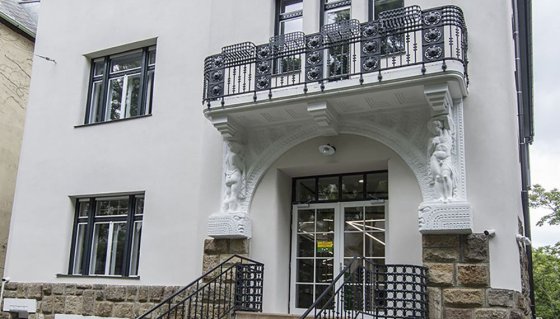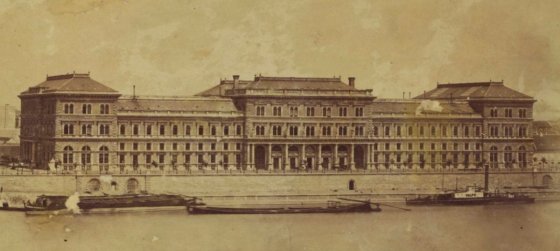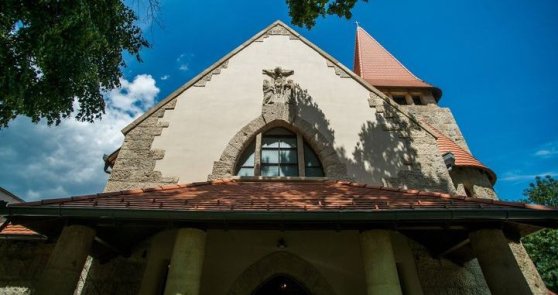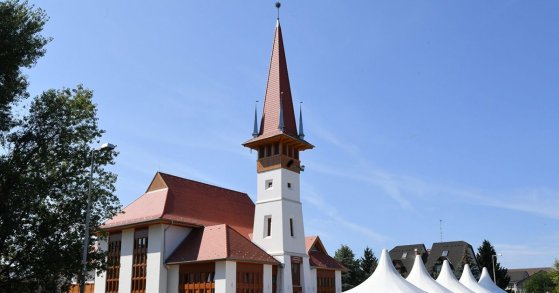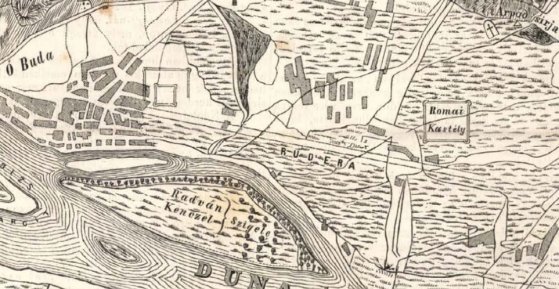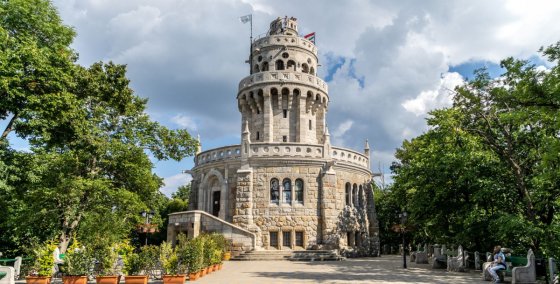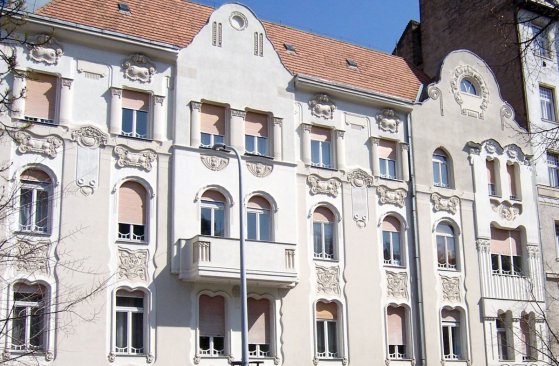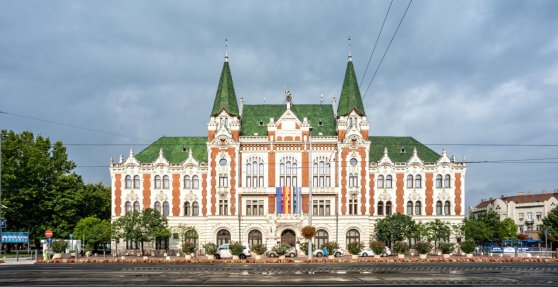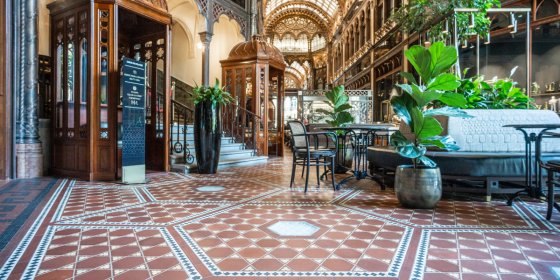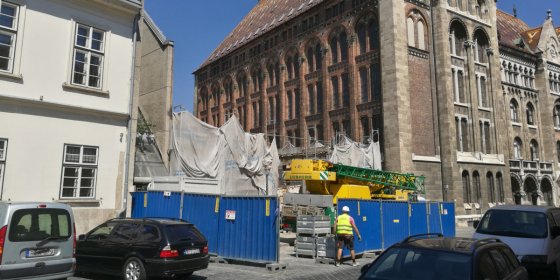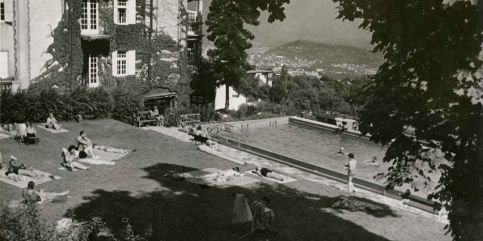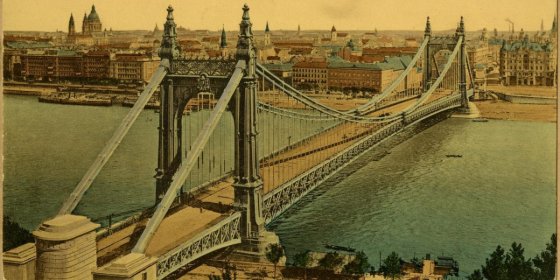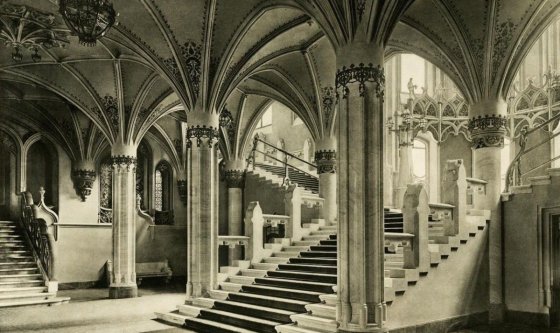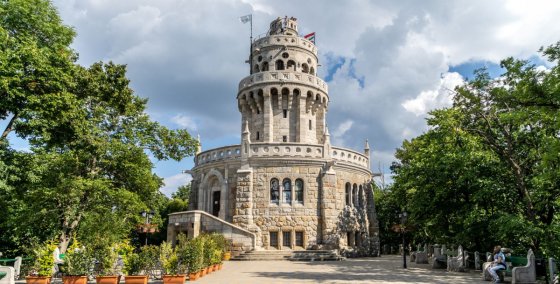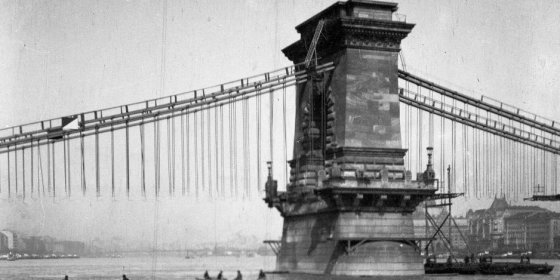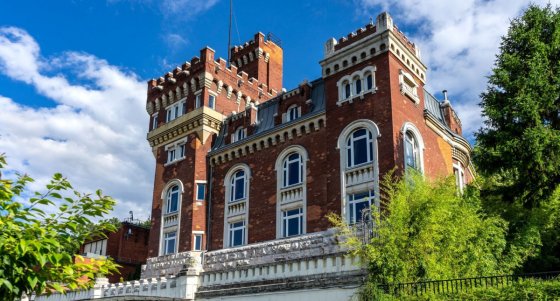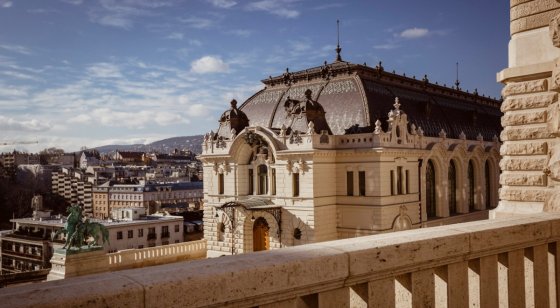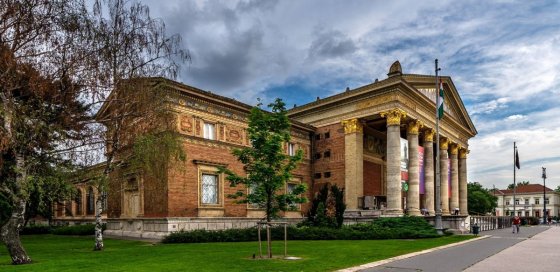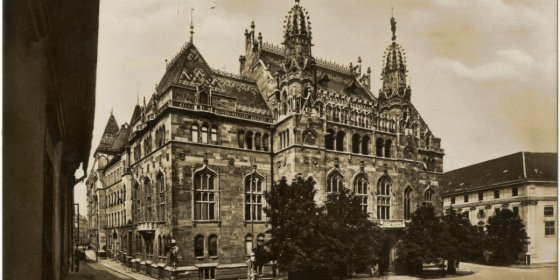 The „intertwined history” of the bridges and the city of Budapest
Which ideas and events have shaped the fate of bridges of Budapest and the cityscape? Alongside many other interesting facts, this question is also answered this newly published book by the Budapest City Archives, which introduces the history of bridges in Budapest.
The „intertwined history” of the bridges and the city of Budapest
Which ideas and events have shaped the fate of bridges of Budapest and the cityscape? Alongside many other interesting facts, this question is also answered this newly published book by the Budapest City Archives, which introduces the history of bridges in Budapest.
Architecture
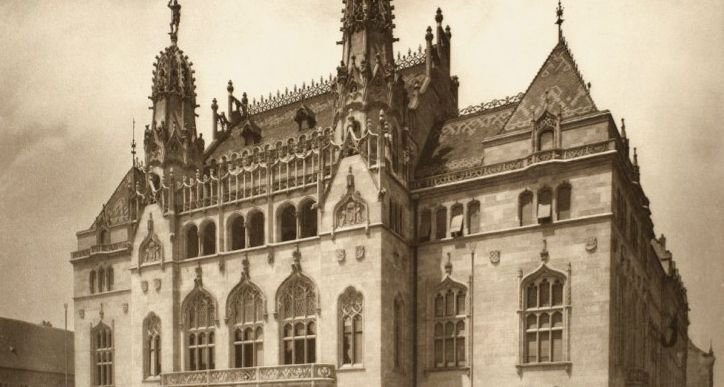 The decorators of the palace built for the Ministry of Finance
The decorators of the palace built for the Ministry of Finance
November 5, 2020 at 9:00 AM
Passers-by are often in awe of the stunning decorations and ornaments that characterise the era of historicism. The palace of the Ministry of Finance on Szentháromság Square is another building on which several masters worked, take a look at their work.
A forgotten house – The origins of Eötvös József College
November 4, 2020 at 9:00 AM
A small street near Kálvin Square bears the name of Pál Gönczy, a writer on educational subjects and teacher at the Reformed Secondary School of Pest. In 1895 a small teacher training institute named after Gönczi's former ministerial superior, Count József Eötvös was opened here. At the time it was known as Csillag Street. Loránd Eötvös founded the College, and its first headteacher was Géza Bartoniek. They are the protagonists of the first 15 years of institution's history, but the small building where early students worked with their professors until 1911, was forgotten.
Lost to war – Domes and ornaments lost during or after World War II to be restored throughout Hungary
November 1, 2020 at 11:00 AM
Three major Budapest buildings will be the first to have their domes and decorations reconstructed within a pilot project. Following in its footsteps, the government hopes to begin a national initiative to restore the domes and ornaments lost in the Second World War or torn down during earlier reconstruction efforts. Plans also include provisions to provide incentives for the restoration of privately owned buildings as well.
Imre Francsek – Lesser known architect behind City Park Skating Rink died 100 years ago
October 30, 2020 at 11:00 AM
The architect behind the ice skating rink in City Park, the colonnade of the Saint Gerard statue, the Buda Civic Casino and several residential buildings. If all his plans had been carried out, Calvin Square and Szabadság Square would be very different. At one point in his career, he even proposed pushing the entire Dreher Palace a few metres to the side. Imre Francsek died one hundred years ago.
A forerunner of modern Hungarian architecture – Remembering Béla Lajta
October 28, 2020 at 9:00 AM
Lajta Béla was one of the most influential Hungarian architects of the first decades of the 20th century. Starting in the footsteps of Ödön Lechner, his art nouveau style grew into a new form and became a forerunner of Hungarian modern architecture. He represented a new approach to the formation of mass while retaining folk-based decorations and the ornamentation of art nouveau, and he connected it to new materials and designed buildings which were monumental in their simplicity. Buildings that have remained beautiful examples of modern urban architecture to the present day.
A modern cinema for Buda – Atrium Movie Theatre completed 85 years ago
October 24, 2020 at 3:00 PM
Átrium was a unique cinema in every respect. It differed from the others in Budapest not only because of its modern building but also in how it was operated. The elegant new auditorium seated 800 people and offered a new quality in both sound and elegance when opened in 1935.
Stunning decorations line the Renaissance-revival palace of the Main Customs House
October 19, 2020 at 9:00 AM
The Main Customs House building, which today houses Corvinus University is a major sight in Budapest. The façade is decorated by 22 statues of figures from Greek-Roman mythology and traditional Hungarian crafts. The main courtyards, staircases, the internal and external decorations all highlight just how great a masterpiece the building is. Construction of the building began 150 years ago in 1870, according to plans drawn up by one of the greatest Hungarian architects, Miklós Ybl.
Defined by Ybl and Lechner
October 15, 2020 at 6:00 PM
When asked to name Hungarian architects, most people will likely mention Miklós Ybl and Ödön Lechner. This is no coincidence; the two architects were prolific and important artists is their age. But how much do people know about their time and their contemporaries? The new volume Ylb és Lechner vonzásában provides information on these.
A Second Hall to Thalia – 145th anniversary of the former Népszínház opening
October 14, 2020 at 10:00 AM
An independent theatre for folk plays that is the Popular Theatre or People's Theatre, Népszínház was opened as a home for the genre which had become popular during the Hungarian National Awakening. The building was completed as a result of an increasingly concerted effort and support from the city. Standing on the present-day Blaha Lujza Square, the structure was designed by the Austrian architects Fellner and Helmer, who were well-known for their theatres. The beautiful building in the eclectic-style was opened with much circumstance on 15 October 1875. The building housed the National Theatre from 1908 and was torn down in the spring of 1965.
Parliament or Palace? – Construction of the Hungarian parliament began 135 years ago
October 12, 2020 at 5:58 PM
On 12 October 1885 150 workers began to dig a 40,000-cubic-metre pit. With this construction of the Hungarian parliament building began based on plans drawn by Imre Steindl. Lasting nearly two-decades the project transformed a neglected, to-be-developed part of the city, Tömő tér, into one of the most symbolic places in the country.
A place of beauty in the heart of the city – 225 years of Bakáts Square
October 10, 2020 at 12:00 PM
There are few places in modern Budapest where the defining institutions of community life can be found side by side. There may not even be such a place any more. Nevertheless, one-hundred or one-hundred and fifty years ago people believed it was vital that they not have to cover large distances to go to church, drop their Children of at school, reach a hospital quickly or sort official matters out. It was best, if church, school, hospital, administrative offices or maybe even a cinema or social club could be found nearby. Bakáts Square was just such a place.
Art Nouveau meets the modern world – The final building planned by Albert Kőrössy Kálmán
October 1, 2020 at 11:00 AM
The renovation of the villa under 26 Benczúr Street was recently completed. The exterior designed by Albert Kálmán Kőrössy has remained an art nouveau villa, while the interior has become a modern space, equipped with state-of-the-art technology. Build as a residential building, it later became a language examination centre, and now houses a centre for education and innovation.
Replanned twice by the great Ybl – Construction of the Main Customs House began 150 years ago
September 30, 2020 at 10:00 AM
The stunning Renaissance revival palace of the Main Customs House by Miklós Ybl is better known today as Corvinus University. The building has defined the view of the Danube embankment since its completion. A lesser-known fact about the building is that it was initially planned for Kossuth Square. Foundation work began but later stopped when Gyula Andrássy (the prime minister in office at the time) supported the Budapest City Council in the dispute about the site. The building was moved to Ferencváros, and Ybl was forced to redraw his plans for the palace twice before construction began 150 years ago.
Renovated Heart of Jesus Church blessed in Városmajor
September 14, 2020 at 5:00 PM
The renovation of the Heart of Jesus Church in Városmajor has been completed. The façade, interior and roof structure were replaced during the reconstruction. Designed by Aladár Árkay, the church served as a hall of worship for ten years and later became a scene of local community life.
A visit to Budapest’s newest Reformed Church
September 11, 2020 at 9:00 AM
The Reformed Church opened in Soroksár on 5 September is reminiscent of the turreted towers of Churches in Kalotaszeg (Țara Călatei, Romania). While the eighth Reformed Church to be completed in Budapest since the fall of communism in Hungary way bear marks of long-standing traditions on its exterior, its interior is of a more modern inclination.
Frigyes Schulek designed a church to stand above Prince Árpád's final resting place
September 9, 2020 at 9:00 AM
Following the Hungarian National millennium of 1896, the country celebrated another millennium in 1907: the one-thousand-year anniversary of the death of Grand Prince Árpád, the ruler who led the conquest of the Carpathian Basin. Furthermore, the current ruler, Franz Joseph, also celebrated the 40th anniversary of his rule in the same year. A law passed to commemorate this double millennium stated that the Church built by King Saint Stephen, which had once stood on the outskirts of Óbuda where Prince Árpád was believed to be buried, should be rebuilt. Frigyes Schulek was commissioned to design the building.
Queen Consort Elizabeth and the most beautiful lookout tower in Budapest
September 8, 2020 at 9:00 AM
The Elizabeth Lookout Tower atop János Hill in Budapest was opened with much ceremony 110 years ago. The tiered, cylindrical tower of snow-white limestone has since then become an unmatched staple of the Buda Hills, as it is visible from large swathes of the city. The present form of the lookout tower should be attributed to Frigyes Schulek. To honour the tower's anniversary, we have collected various images and stories from its past.
New Drug Research Centre to open next year in former hospital building
August 24, 2020 at 9:00 AM
The capital has few hospital buildings opened more than a hundred years ago that do not need to be thoroughly renovated, remodelled or modernised. There was also a period, not so long ago, when such institutions were closed rather than maintained. But the list of empty unused buildings also goes on and on, as they await new use of demolition. Fortunately, there are already examples of healthcare buildings being renovated without major changes in function. An example is the former Schöpf-Merei Ágoston Hospital.
Újpest City Hall 120 years old
August 22, 2020 at 9:00 AM
One of the symbols of Újpest, the town hall, which was inaugurated 120 years ago, on 21 August 1900, was designed by the outstanding architects of the age, Ármin Hegedűs and Henrik Böhm. Originally a town hall and then city hall from 1907, the historic building, which bears Art Nouveau features, is still in the service of the local population.
A footprint of Budapest – Stunning paving stones hide in old building around Budapest
August 15, 2020 at 10:00 AM
How many times have we been told to watch out steps? The saying can be useful when walking the streets of Budapest near open doorways because the capital's architecture is more than the facades facing the street! Entering through the gates, we drop into a closed world, where those paying attention will discover many beautiful details. The most colourful of these, in addition to painted glass windows, are floor pavings.
Most of the National Electric Load Distributor in the Castle has been demolished
August 14, 2020 at 9:00 AM
The demolition of the controversial-looking industrial building next to the Bécsi Kapu Square Palace of the Hungarian National Archives has progressed quickly in recent weeks. Only the tower, part of the iron structure and a firewall remain. The former National Electric Load Distributor that has been in a dilapidated condition for a long time will be replaced by a house
Breathtaking panorama for high-altitude bathing – The forgotten memories of swimming on Svábhegy
August 11, 2020 at 1:00 PM
At the time of its construction, the Svábhegy open-air pool was characterised as an “artistic and significant work for tourism” at the opening in July 1934. The former spa, located at 430 metres above sea level, designed by our legendary athlete and architect, Alfréd Hajós, deserved the attributes above with its beautiful geographical location and cleverly solved architectural realisation.
How have the bridges of Budapest changed after their construction?
August 10, 2020 at 12:00 PM
Pestbuda's summary presenting the reconstruction of the Chain Bridge in 1914 received many comments about the bridges of Budapest, their modifications and redesigns. Please join us on a glance through which bridge has changed in the decades since its construction.
The Gothic-Revival wonders of Budapest
August 6, 2020 at 9:00 AM
The image of Budapest today is defined by a prolific period, the architecture of dualism. The most famous buildings of the capital, such as the Fisherman's Bastion, the Opera House, the Parliament and Saint Stephen's Basilica, were built in the second half of the 19th century. This period is characterized by a high degree of stylistic pluralism. Join PestBuda on a walk through the most stunning buildings in Budapest.
The highest point of Budapest – Elizabeth Lookout turns 110
August 2, 2020 at 3:00 PM
One of Sisi's favourite places to visit in Budapest. The highest point of the city houses one of Budapest's most popular lookout towers, the Elizabeth Lookout. The building, designed by Pál Kluzinger and Frigyes Schulek, was opened 110 years ago. Pestbuda climbed János Hill to honour the anniversary.
The Chain Bridge, a symbol of the country completely demolished in 1914
July 27, 2020 at 12:00 PM
During the renovation of the Chain Bridge, it will be necessary to go back to the plans of 1914. But why will they follow the 1914 version when the bridge was built between 1839-1849?
A little Genoa on Gellért Hill
July 21, 2020 at 11:00 AM
The Hegedüs Villa or originally the Schoch Villa is well known in Budapest, although few people know by its name. The mass of the building rises above the statue depicting Saint Gerard and the waterfall, so it is immediately noticeable when people drive from Pest to Buda across Erzsébet Bridge. Its medieval forms are less typical of early 20th century Hungarian architecture, according to urban legend, it is a copy of an Italian building. Pestbuda now reveals if the legend is true.
"No one prepared us for the breathtaking experience" - The Riding Hall in Buda Castle Reborn
July 17, 2020 at 9:00 AM
People have admired the Lovarda ('riding hall') in Buda Castle, recently completed within the framework of the National Hauszmann Program, from the outside. They have not been able to look around inside yet, only see the beautiful interiors in photos. Pestbuda editors had the opportunity to visit the building as part of a guided tour. Alajos Hauszmann designed the riding hall, which was completed in 1901. Hence it is no surprise that the guided tour was called Hauszmann's Horses on the website of the National Hauszmann Program.
Renovation of Hall of Art to begin as Government confirm priority status
July 15, 2020 at 10:00 AM
The Government has declared the renovation of the Hall of Arts to be a project of national economic importance and investment of high public interest. The building was originally constructed in 1896 as part of the events to commemorate the millennium of Hungarians living in the Carpathian Basin. However, when work will begin on the building, designed by Albert Schickedanz and inaugurated by Franz Joseph, is currently unknown.
How Buda Castle became a government district
July 8, 2020 at 11:00 AM
The old buildings of Buda Castle are markers of an eventful history. Several of these buildings once housed government offices and ministries, such as the palace designed by Sándor Fellner on Holy Trinity Square now being renovated. but how did governance become o central to Buda Castle? Its a story that goes back earlier than the 20th century.
More articles
 The „intertwined history” of the bridges and the city of Budapest
Which ideas and events have shaped the fate of bridges of Budapest and the cityscape? Alongside many other interesting facts, this question is also answered this newly published book by the Budapest City Archives, which introduces the history of bridges in Budapest.
The „intertwined history” of the bridges and the city of Budapest
Which ideas and events have shaped the fate of bridges of Budapest and the cityscape? Alongside many other interesting facts, this question is also answered this newly published book by the Budapest City Archives, which introduces the history of bridges in Budapest.
 The Bridge Report, which brought a turning point in the history of Budapest
A travel report that changed the history of Pest and Buda, as well as Hungary. The little book contributed to the change of half a thousand years of legal customs and the implementation of an investment of unprecedented size and technical quality. This book was The Bridge Report [Hídjelentés in Hungarian].
The Bridge Report, which brought a turning point in the history of Budapest
A travel report that changed the history of Pest and Buda, as well as Hungary. The little book contributed to the change of half a thousand years of legal customs and the implementation of an investment of unprecedented size and technical quality. This book was The Bridge Report [Hídjelentés in Hungarian].
 Drama on the university wall - The heroic monument was planned 95 years ago
In the constant hustle and bustle of the Egyetem Square in Pest, the students may not even notice the monument that decorates the short section of wall between the church and the central building of ELTE. However, it commemorates their predecessors, the heroes who fought for their country in World War I, and those who heroically helped them. The first design of the dramatically collapsing soldier was born in 1928, ninety-five years ago.
Drama on the university wall - The heroic monument was planned 95 years ago
In the constant hustle and bustle of the Egyetem Square in Pest, the students may not even notice the monument that decorates the short section of wall between the church and the central building of ELTE. However, it commemorates their predecessors, the heroes who fought for their country in World War I, and those who heroically helped them. The first design of the dramatically collapsing soldier was born in 1928, ninety-five years ago.

